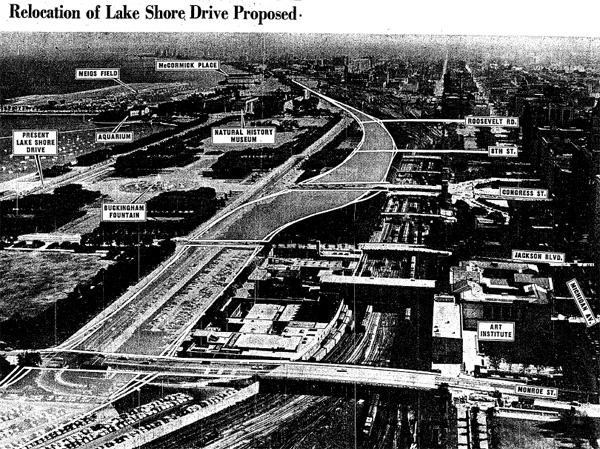As Steven Vance and Jon Hilkevitch report, a host of local civic groups have banded together to generate public input on the rebuilding of North Lake Shore Drive, which has to get overhauled in the next few years due to age.
In preparation for public meetings on the LSD work, the 15 civic groups—including the Active Transportation Alliance, the Metropolitan Planning Council, the Center for Neighborhood Technology, and others—have released suggestions designed to slow down Lake Shore Drive, including:
* A "maximum 35mph design speed," not just a speed limit, with "no increase in the number of lanes
* Bus-only/Bus Rapid Transit lanes
* A "separate bike facility" to separate recreational Lakefront Trail users from bike commuters
It sounds a bit like the suggestions Randy Neufeld gave Chicago for how to make Chicago better:
Chicago could be the first city in the world with an express lane—on our signature road!—dedicated to emerging green urban mobility. There are big economic benefits to a Lake Shore Drive that attracts tourists, that serves residents who choose not to drive, and that is 100 percent reliable, regardless of events and weather. And all this could be done within five years.
Which makes sense; Neufeld is an ATA board member.
LSD has long represented where Chicago stands in terms of urbanism and transit. What's remarkable is that it didn't turn into a full-fledged expressway. In 1992, the Reader's Harold Henderson reported on the then-latest attempt to make the Drive bigger and faster:
More than 30 years ago, Mayor Richard J. Daley proposed that Lake Shore Drive be widened and turned into a real expressway, running south through Jackson Park, behind the Museum of Science and Industry, and down Stony Island Avenue to the then-smooth Chicago Skyway. Daley eventually lost that battle–after Hyde Parkers risked arrest by tying themselves to trees along the route–but the war isn't over yet.
The latest skirmish was joined this May, when lakefront aldermen received letters from Aristide Biciunas, executive director of the Chicago Area Transportation Study (CATS). Biciunas announced that the state of Illinois is now studying how to make Lake Shore Drive "supplement the expressway system in handling long-haul through traffic," and invited the aldermen to attend an "advisory panel" meeting June 1.
Just count your lucky stars the Chicago Plan Commission didn't get its way. In 1960, they planned to bulldoze most of Grant Park, turning it into an expressway running within a stone's throw of Buckingham Fountain:

From what I can see that would have wiped out all of Grant Park abutting Columbus—what's now tennis courts, baseball fields, the Art Institute's Modern Wing, Lurie Garden, and Maggie Daley Park. What's now Millennium Park would be neighbors with an expressway. It's not impossible to remove an expressway from a city—numerous cities have done so—but it's a long and politically fraught process to stop the not-train of vehicular progress.


